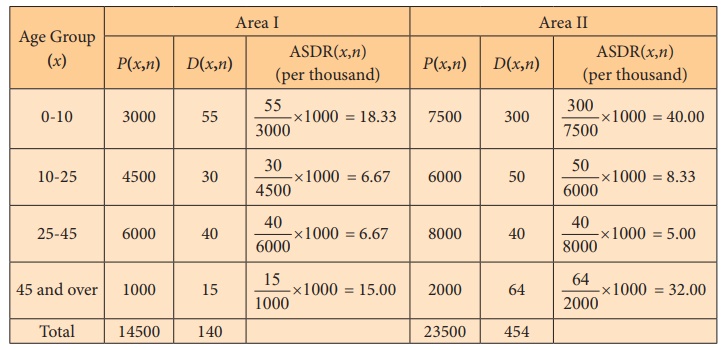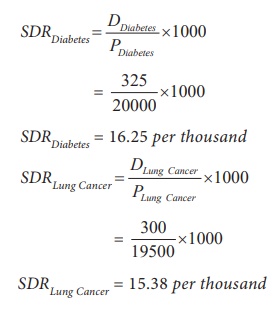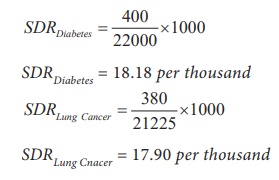Vital Statistics - Mortality and Its Measurements | 12th Statistics : Chapter 8 : Vital Statistics and Official Statistics
Chapter: 12th Statistics : Chapter 8 : Vital Statistics and Official Statistics
Mortality and Its Measurements
Mortality and Its Measurements
Mortality refers to the deaths, which occur in the
population/community/region due to sickness, accidents, etc.
Several rates are used for measuring mortality. We will discuss
the following primary mortality rates.
(i) Crude Death Rate
(ii) Specific Death Rate
(iii) Infant Mortality Rate
(i) Crude Death Rate
Crude Death Rate (CDR) is the simplest type of death rate,
which relates the number of deaths in a specific community or region to
the population size of the community in a given period, preferably on yearly
basis. The formula used to calculate this mortality rate for a given period is
CDR = D/P ×1000
where
D: Number of deaths in the population or community during the given
period, and
P: Number of persons in the population or community during the
given period.
Example 8.1
There were 15,000 persons living in a village during a period and
the number of persons dead during the same period was 98.
Then, the CDR of the village can be calculated from
CDR = [D/P] ×1000
as
CDR = [98 / 15000] ×1000 = 6.53
per thousand.
In some cases, information about the population may be provided in
such a manner that people in the population are grouped according to their age
into mutually exclusive and exhaustive age groups. The CDR can also be
calculated based on such kind of information.
Example 8.2
People living in a town are grouped according to their age into
five groups. The number of persons lived during a calendar year and the number
of deaths recorded during the same period are as follows:

Calculate crude death rate of the town.
Solution:
The total number of deaths occurred in the town, irrespective of
the age, is 1385 and the population size is 42,000. Therefore, the CDR
of the town can be calculated as
CDR = [1385/42000] ×1000 = 32.98
Thus, the Crude Death Rate of the town is 32.98 per thousand.
CDR is the widely used mortality measure. It is popular, because it is
very easy to compute. However, it is only a crude measure of mortality,
which does not take into account of the age and sex, on the whole, of the
population/community/region. The probability of death may not be same at all
ages. Hence, if the age distribution of two different communities are not
similar, then comparing the communities based on their CDR can mislead.
Also, use of CDR may again be misleading, since the probability of death
may vary over gender, though they are at the same age.
(ii) Specific Death Rate
Mortality pattern may differ in different sections/segments of the
population such as age, gender, occupation etc.
Specific Death Rate (SDR ) can be calculated
exclusively for a section of the population. The SDR can be
calculated for a group of persons, who are distinguished by age or gender or
occupational class or marital status. The formula to calculate SDR is

where
DS refers to the number of deaths in a specific section of population
during the given period, and
PS refers to the total number of persons in the specific section of
population during the given period.
SDR s can be calculated for any age group, gender, religion, caste or
community. If the death rates are calculated for different age groups,
say, 0 -5 years, 5-15 years, 50- 60 years, they are called age specific death
rates (ASDRs) . In the age group (x,x+n), all the persons in the
population or in its section, who have attained the age of x years and
the persons with age less than x+n years, are included in the age group.
If
D(x,n) denotes the number of deaths in the age group (x,x+n)
recorded in a given region during a given period, and
P(x,n ) denotes the number of persons in the age group (x,x+n)
in the region during the same period, then
ASDR for the age group (x,x+n) for the given region during the
period is given by

The death rates, calculated for persons belonging to different
gender, is called as gender specific death rate. The SDR can also be
used to compare the death rates due to different kinds of seasonal diseases
such as dengue, chikungunya, swine flu.
The SDR helps to measure the death rates for different
sections/segments of the population unlike CDR. ASDR and SDR
for gender can be used to compare the death rates of the respective sections of
the given population in different regions.
Example 8.3
Number of deaths recorded in various age groups in two areas, viz.,
Area I and Area II and the population size in each age group are given in the
following table.

Find the crude death rates and age specific death rates of Area I
and Area II.
Solution:
Age Specific Death Rate can be calculated for each age group using
the formula
ASDR ( x , n) = [ D ( x , n) / P ( x , n) ] ×1000

Calculation of the ASDR for both the areas in each age
group is presented in the following table:

CDR of Area I = [140/14500]
×1000 = 9.66
per thousand
CDR of Area II = [454/23500]
×1000 = 19.32
per thousand
Example 8.4
The following are the information about the number of persons who
are affected by Diabetes and Lung Cancer and the number of persons died due to
each cause of death during a calendar year in two different districts:

Find the Illness specific death rates for the two districts. Also,
compare health conditions of both the districts with reference to these two
causes of death. Assume that a person affected by Diabetes is not affected by
Lung Cancer and vice-versa.
Solution:
The SDR due to the two causes of death are calculated as
follows:
SDR of District A

SDR of District B

In both the districts, death rates are more due to Diabetes in
comparison with Lung Cancer. Among the two districts, District B has relatively
more death rate due to both Diabetes and Lung Cancer.
The SDR can be calculated with respect to gender also. For
example, SDR for males in a given region during a given period can be
calculated as

Here, DMale is the number of male deaths in the
region during the specified period, and PMale is the male
population size in the region during the specified period.
(iii) Infant Mortality Rate
‘Infant’ means a baby of age less than a year. Infant Mortality
Rate (IMR) is defined as the number of infant deaths per thousand
live births in a period or children die before they attain age of one year. The
following formula is used to calculate infant mortality rate

where
DInfant denotes the number of deaths of infants in a
population during a period, and
PInfant denotes the number of live births in the
population during the period.
Child Mortality Rate: Child mortality is the death of a child before
the child’s fifth birth
day, measured as the under 5 child mortality rate (U5MR).
Example 8.5
The number of live births recorded and the number of infants died
in a town during a given period are respectively 400 and 25. Calculate, from
these information, the infant mortality rate of the town for the period.
Solution:
The IMR of the town is given by
IMR = 25 / 400 ×1000
IMR = 62.50 per thousand.
Related Topics